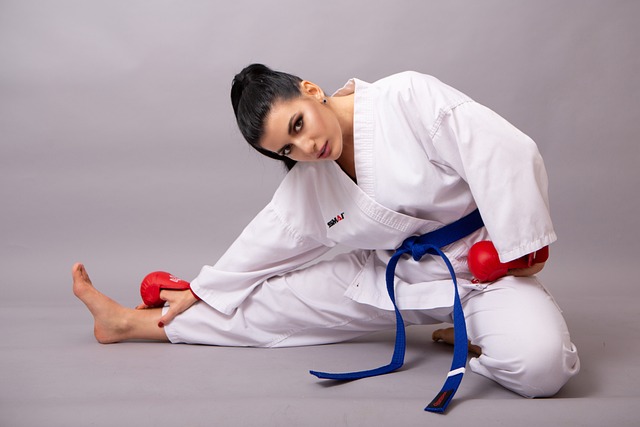Korean-born taekwondo is a martial art that is well-known across the globe for its powerful kicks, acrobatic maneuvers, and explosive force. It’s a discipline that prioritizes developing a strong mind and soul in addition to physical prowess and technique.

Taekwondo’s origins are in the old Korean martial arts, which date back more than 2,000 years. Taekwondo was developed in the 1950s when a group of Korean martial artists combined their techniques. With millions of practitioners in more than 200 nations, it is now one of the most well-liked martial arts globally.
One of the main principles of Taekwondo is self-control. Practitioners are encouraged to create and strive toward objectives, whether they include learning new skills or participating in competitions. There is also a strong emphasis on showing respect to others, particularly to those in positions of authority or expertise. This develops a helpful learning atmosphere and a feeling of community.
A vital aspect of Taekwondo is physical fitness. Practitioners use kicks, punches, and forms—patterns of movement—to build strength, flexibility, and cardiovascular endurance. Furthermore, students gain confidence and a feeling of security by learning how to defend oneself in actual life circumstances.
Still, Taekwondo is not only about fighting. Additionally, it fosters emotional and mental health. Practitioners learn how to concentrate on the present moment and declutter their thoughts via mindfulness exercises and meditation. Additionally, they learn how to regulate their emotions and react well under pressure.
Taekwondo provides opportunity for competition and recognition in addition to personal improvement. Every year, a number of events and tournaments at all levels—from regional to worldwide—are organized. By proving their mastery of a variety of methods and forms, practitioners may rise to higher rankings.
In conclusion, Taekwondo is a comprehensive martial art that has advantages for the mind, body, and soul. Taekwondo is a rewarding sport that may assist people in reaching their objectives, whether they are about building a strong character, learning self-defense, or being more physically fit.
Assortment of methods
A range of techniques, including punches, kicks, blocks, and strikes, as well as forms or patterns that sequence these techniques, are usually taught in taekwondo instruction. In addition, sparring—a regulated combat style done while wearing protective gear—and practical self-defense methods are taught to practitioners. Taekwondo is distinct in that it places a strong focus on powerful, fast, and accurate kicking techniques. A wide range of kicks, including roundhouse, spinning, front, and side kicks, may be taught to practitioners. Physical strength, flexibility, balance, and coordination are needed for these methods. Exercises for conditioning are another part of taekwondo training that help with endurance and general fitness.

Cardiovascular exercises, plyometrics, calisthenics, and jumping drills are a few examples. Exercises for warming up and stretching are also crucial for increasing flexibility and preventing injuries. Taekwondo places a strong emphasis on mental attention and discipline in addition to physical training. Meditation methods may be learned by practitioners to help them focus more intently on the present moment and quiet their thoughts. They also learn how to create goals, be persistent, and exercise self-control. The colored belt system is the foundation of Taekwondo’s grading scheme, where each color denotes a distinct competency level.
White belts are followed by yellow, green, blue, red, and black belts. Although the black belt is the highest degree, practitioners never stop learning and honing their craft. To sum up, Taekwondo is a martial art that has many advantages for both the body and the mind. It’s a disciplined practice with a focus on self-control, respect, and personal development. Taekwondo is a fulfilling practice that may assist you in reaching your objectives, whether you’re interested in competition, self-defense, or just becoming fitter and feeling better.
Help for Taekwondo
Taekwondo is well known for emphasizing good sportsmanship and showing consideration for opponents. It is required of practitioners to compete with excellent sportsmanship and to treat their opponents with respect, even when they lose. This imparts important knowledge about grace under duress, humility, and respect.
Additionally, taekwondo provides a healthy outlet for reducing stress and anxiety. Exercise has been shown to reduce stress and elevate mood; Taekwondo practitioners may also benefit from the mental concentration and discipline necessary to handle tension and anxiety.
Furthermore, Taekwondo offers a fantastic means of staying active and maintaining a healthy lifestyle. Strength, flexibility, cardiovascular health, and general fitness may all be enhanced with regular practice. In addition, it may help lower the risk of chronic illnesses including diabetes, high blood pressure, and heart disease while promoting weight reduction and muscle growth.
In conclusion, Taekwondo is a martial art with many mental, emotional, and physical advantages. It’s a disciplined practice with a focus on self-control, respect, and personal development. Taekwondo is a rewarding sport that may assist people in reaching their objectives and leading healthy, satisfying lives, regardless of whether they are interested in competition, self-defense, or just becoming fitter and feeling better.
Reasons Taekwondo gained notoriety
Taekwondo is a well-liked martial art that has become well-known around the world because of its special qualities and many advantages. Its focus on high, quick, and forceful kicks has made it both a visually stunning and practical self-defense method. Taekwondo’s popularity across the globe has also been aided by its cultural importance as a national sport in Korea, where it has been highlighted in a number of ceremonies and festivals. Its renown has also grown as a result of being available to millions of fans thanks to its involvement in the Olympics. Finally, Taekwondo is a useful exercise for individuals of all ages and backgrounds because of its focus on discipline, respect, and personal development. These qualities and teachings may be applied to many aspects of life.

In conclusion, Taekwondo’s distinctive qualities, cultural significance, Olympic recognition, and emphasis on self-improvement and discipline have all contributed to its rise to prominence as a martial art. Its popularity has also been aided by other elements, including as its inclusion in action films, efficacy as a self-defense tactic, encouragement of physical fitness and health, and deep cultural importance in Korea. All things considered, Taekwondo provides a holistic experience that helps practitioners psychologically, emotionally, and physically while encouraging virtues like self-assurance, sportsmanship, and respect. Because of this, Taekwondo has grown to be a well-liked martial art that people of all ages and backgrounds enjoy practicing all around the globe.
Taekwondo poses a risk.
Getting hurt is one possible danger that comes with practicing Taekwondo. High-impact kicks, blows, and throws are part of the exercise, and they may cause fractures, sprains, strains, and bruising. But with the right instruction and precautions, the chance of harm may be minimized.
The possibility of brain trauma, including concussions, is another possible concern. Even with protective equipment on, there is always a risk from high-impact head injuries.
In addition, certain forms of Taekwondo include the use of weapons like swords, knives, and sticks, which may be dangerous if not used properly or supervised.
However, it is important to remember that Taekwondo, like any other martial art, places a strong emphasis on safety and respect for others. Minimizing the danger of damage to oneself or others requires proper training, supervision, and method control.
All things considered, Taekwondo has certain inherent hazards, just like any physical exercise, but the chance of being hurt may be reduced with safe practices, the right instruction, and responsible conduct. The technique and its benefits are still available to practitioners.
Most renowned nations
Taekwondo is a well recognized martial art that is practiced in many different nations. Nonetheless, several nations have a noteworthy Taekwondo heritage and influence. The following are a some of the most well-known Taekwondo-playing nations:
South Korea: The birthplace of taekwondo, the country regards it as a national sport and an essential component of its culture. Numerous important Taekwondo rituals and events have long been held across the nation.
United States: With millions of practitioners and hundreds of competitions and events organized annually, taekwondo is immensely popular in the US.
Brazil: With a rich history in Taekwondo, Brazil has produced several elite fighters. Major Taekwondo tournaments are held throughout the nation, such as the World Taekwondo Grand Prix and the Pan American Championships.
Iran: The Iranian Taekwondo team is strong and has won several medals in international tournaments. The nation is home to a sizable Taekwondo community and organizes many significant tournaments each year.
Mexico: One of the most well-liked martial arts there is taekwondo, which has a sizable practitioner base and several annual competitions and events. Many accomplished Taekwondo practitioners, including Olympic medalists, have come from this nation.
Mastering the Art of Kickboxing: Techniques, Benefits, and Training Tips
Taekwondo is also very popular in China, Turkey, Russia, and Spain, among other nations. Read more
